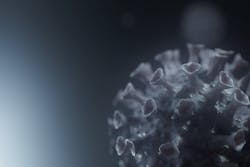New research from Lawrence Berkeley National Laboratory (Berkeley Lab) could help get reliable instant tests on the market, according to a news release from the organization.
A study led by Michal Hammel and Curtis D. Hodge suggests that a highly sensitive lateral flow assay – the same type of device used in home pregnancy tests – could be developed using pairs of rigid antibodies that bind to the SARS-CoV-2 nucleocapsid protein. Such a test would only require a small drop of mucus or saliva, could give results in 15 minutes, and could detect a COVID-19 infection one day before the onset of symptoms. Their work was published in the journal mABs.
Rapid antigen tests use antibodies to detect specific parts of the viral particle itself. Current antigen tests have a very low rate of false positives, but are plagued by high false negative rates, and therefore can’t replace PCR tests for definitive COVID-19 diagnosis. If a more accurate antigen test was brought to market, it could serve as a helpful initial screening tool similar to how home pregnancy tests work. In the case of a positive result, the user would need to begin appropriate precautionary measures (isolation and other transmission-prevention behaviors) and then have the diagnosis confirmed by an official test at a health clinic.
"As we move toward gaining normalcy and reopening economies worldwide, there is continued demand for rapid, low-cost tests that can be self-administered without the need for a trained professional,” said Hammel, a biophysicist in Berkeley Lab’s Biosciences Area. “Currently used COVID-19 PCR tests are expensive, at about $100 per test, and on average, U.S. labs are performing one million tests per day. An accurate rapid antigen test could cost $1 each and eliminate the wait time.”
Hammel, Hodge, and their colleagues used small angle X-ray scattering (SAXS) performed at Berkeley Lab’s Advanced Light Source (ALS) to examine about 20 antibody-antigen interactions. Their data showed that a particular pair of monoclonal antibodies bound to the nucleocapsid protein very strongly and stably, in part due to the antibodies’ rigidity. All antibodies vary in their degree of rigidity based on the amino acid sequence of their “arms,” which are the part of the Y-shaped molecules that bind to antigens. “The combination of the two rigid antibodies was also observed to increase networking – a process in which multiple antibodies bound to the same antigen at different sites form larger clumps or ‘networks,’” explained Hodge, a postdoctoral researcher and first author on the study.
Antibody networking and high binding stability are known to improve the sensitivity of lateral flow assays, and researchers have long speculated that antibody flexibility plays a role in both properties. But studying the physical dynamics of antibody-antigen pairs to find the most effective antibodies is very difficult with traditional imaging techniques, which require the molecules to be stabilized or crystallized. The SAXS technique developed by Hammel and his colleagues allows scientists to examine antibodies and antigens in their natural state, i.e., when moving freely in a liquid.

